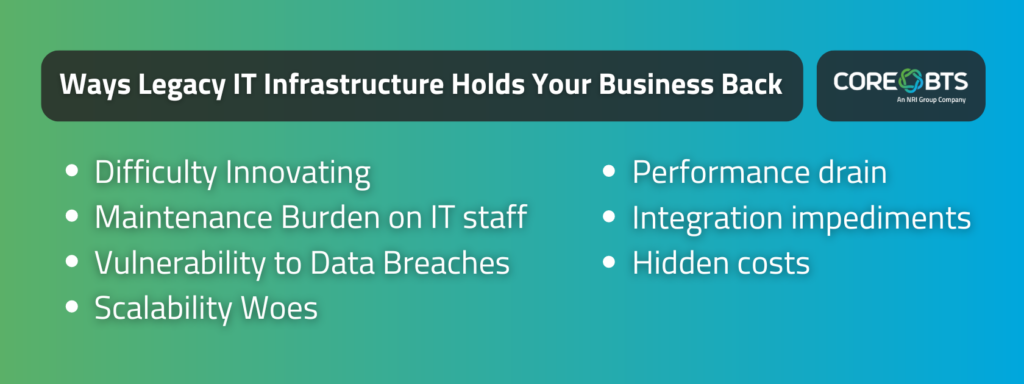So, your legacy infrastructure gets the job done. But is it efficient? Can you honestly say that it doesn’t need an upgrade?

The decision to maintain the status quo looks good on paper.
In many cases, legacy infrastructure has become indispensable to mission-critical operations. It has accumulated valuable business data, streamlined workflows, and is entrenched in the organizational culture. Plus, replacement isn’t cheap or easy, as extensive planning and testing are needed before migration even starts to avoid disruptions.
These are valid reasons to cling to an infrastructure that has served you well for so long. But have you considered that your business may not be living up to its full potential?
Here are seven ways outdated infrastructure can hold your business back:
1. Difficulty Innovating
Outdated IT infrastructure can’t handle the demands of modern applications and technologies. Their slow processing power and limited storage capacity are major roadblocks when implementing cloud solutions, data analytics, AI, and other modern technologies. This robs your business of the opportunity to embrace game-changing innovations that enhance productivity, staff morale, and customer experience.
2. Maintenance Burden on IT staff
With legacy infrastructure, it’s common for IT staff to spend more than half their time on troubleshooting, patching, fixing bugs, and other maintenance tasks. This is highly inefficient.
Think about it. Who’s left to innovate when your best people are tied up putting out fires? Who drives your business growth and digital transformation agenda?
Here’s a hint: No one.
Plus, legacy infrastructure maintenance often requires rare specialized skills and knowledge. While your existing team may have the prerequisite expertise, what happens when key personnel decide to leave? With the prevailing tech talent shortage, it’s hard enough to fill standard IT positions, let alone find people willing to work with outdated technology.
3. Vulnerability to Data Breaches
It’s not a stretch to imagine that future cyber attacks will mainly target legacy infrastructure due to their lack of critical security patches and updates.
Failing to modernize can have far-reaching consequences.
If in doubt, consider the recent Colonial Pipeline attack. Darkside (a hacker group) infected Colonial Pipeline’s outdated IT network with ransomware, disrupting oil delivery and forcing it to shut down. The attack’s impact trickled down, leading to flight cancellations and panic buying across several gas stations in the United States.
Now, imagine if such a nightmare befell your organization.
Operations would be disrupted, customer information compromised, and trust shattered. Regulators would come knocking at your door for data privacy and security violations. And that’s not even taking the financial repercussions into account. Per recent IBM estimates, that figure is a staggering $4.88 million.
4. Scalability Woes
Even without a data breach, outdated infrastructure could still stifle growth. If the infrastructure is fully on-premise, rather than in the cloud or hybrid, adding new users, handling increased data volumes, and scaling other operations could require additional investment in equipment. Not only is this costly, but installation takes time.
The inability to readily adapt to new demands is something to avoid as it makes it difficult to expand and catch up with agile competitors once they capture the lion’s share of the market.
5. Performance Issues
Slow network speeds, outdated hardware, and inefficient software lead to constant system lags, application crashes, and overall performance issues. These are major productivity killers. It’s difficult for employees to deliver projects on schedule when the underlying infrastructure doesn’t allow them to move seamlessly between tasks.
The impact of poor performance doesn’t end there—it trickles down to customers, who experience delays and frustration.
6. Integration Impediments
Another challenge is that systems in a legacy infrastructure are often stand-alone solutions. They use different communication protocols, programming languages, and data structures and often struggle in today’s highly modular, interconnected environments driven by cloud services, APIs, and microservices.
Every time you need to integrate with a modern application or system, a new API has to be built from scratch. During migration, unstructured data may become unusable.
These integration impediments often create data and communication silos, making it difficult for employees to promptly access the data they need for critical decisions promptly. Cross-functional collaboration between departments also takes a hit. And back-and-forth manual data entry between systems exponentially increases errors, inconsistencies, and reworks.
Overall, business agility is stifled, hindering you from seizing new opportunities.
7. Hidden Costs
The fact that legacy infrastructure could break down at any moment doesn’t inspire much confidence, either. Not only is maintenance a major drain of valuable IT staff time, but it’s also not cheap.
Plus, money sunk into repairs, parts, and maintenance isn’t the only hidden cost.
Unexpected downtime often causes productivity disruptions and business loss. According to recent estimates, businesses lose $9,000 every minute that mission-critical applications and hardware are offline. For healthcare, manufacturing, government, and other high-risk industries, that figure can surpass $5 million per hour.
The financial repercussions of data breaches are also quite severe. Every day you persist with legacy infrastructure is a $4.88 million risk. It also puts your reputation in jeopardy. That’s something you can’t afford.
While investing in a modern, secure, and reliable IT infrastructure seems costly upfront, the long-term savings—from fewer repairs, minimized downtime, streamlined operations, and 24/7 protection against breaches—are higher.
Let Go And Live With Less Hassle
Understandably, parting ways with an infrastructure that has served you well for years is hard. However, if it’s not helping you compete efficiently in today’s fast-paced digital landscape, you’re only setting yourself up for stagnation. Sooner or later, the legacy infrastructure will become a thorn in the organization’s side and negatively impact its bottom line.
The faster you modernize, the more benefits you gain. So don’t hesitate. Invest in a modern infrastructure today and watch your business unlock a new world of possibilities.
Contact Core BTS to equip your business with a modular hybrid infrastructure that fits today’s and tomorrow’s needs.





Share on